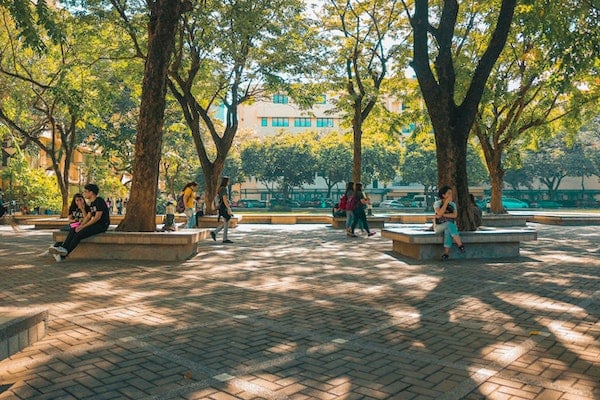Published on
Centralizing Approaches to Better Serve Adult Learners

More adults are looking to higher education to keep them relevant in the job market and institutions need to shift their approaches to help serve this audience. This means centralizing approaches to create a more seamless experience for both staff and students. In this interview, Sean Pitzer and Claudia Tomany discuss the importance of serving adult learners, the enrollment funnel for adult learners, and how a centralized approach can help grow revenue and enrollment growth.
The EvoLLLution (Evo): Why is it important for colleges and universities to shift their focus toward serving adult learners?
Sean Pitzer (SP): Number one—particularly in the Midwest, Northeast and anywhere that’s not on the coast—there are demographic shifts. There’s a net migration outflow of traditional-aged college students and high school graduates. Reviewing national data, we know 30 million-plus people in the U.S. have some college credit and coursework but no degree. And that gap is composed of people at the associate, bachelor’s, master’s levels and on up. So, as regards graduate programs, each institution has its own personality, but many of us are relying on our undergraduate students to matriculate into our continuing education and professional development programs, as well as our graduate certificates and master’s degrees. We talk about our analytics, but where are our biggest feeders? Where is our primary source of current graduate students?
It is, in fact, our own undergraduate programs, which presents us with both challenges and opportunities. An opportunity because we have that regional presence; we’ve had students come through our undergraduate programs, succeed and want to come back for a graduate credential. So, in looking at the demographics and numbers readily available, they tell a story of where our growth opportunities lie, and that’s in adult education and among degree completers. That’s the primary demographic growth area, if not the only demographic growth area in many places. The challenge is that the number of high school graduates and traditional-aged college students is shrinking at an accelerating rate.
So, we must think about resources, whether it’s course scheduling, online availability or childcare to access potential students who are not currently in school. We know there’s a deep hunger and need for higher education to upskill and insulate oneself from economic cycles in terms of employability. Federal and local data provide an opportunity for us to step into an untapped space and innovate to serve an extremely large and important population with a direct impact on the economic success not only of our city and region but across the state, country and world.
Claudia Tomany (CT): I couldn’t agree more. There are some reasons that actually make it desirable in many cases for students to take a break after the bachelor’s degree and begin their professional journey before they return for more learning because, to succeed in most spaces, you need a combination of professional experience and education. If you have been a student your whole life and continue straight into the master’s degree, you exit with a lot of knowledge about the area but very little in applicable skills and real-world experience.
We find that students who return after working for five, six, seven years are in a totally different space in terms of understanding the importance of what they’re learning and how they can use it. Another advantage they frequently have is employers willing to pay for their master’s degree or an income level that allows students to pay outright for the degree. So, they’re not adding to a huge debt load that some of the students have when they graduate from an undergraduate degree. There are many different advantages to planning your career like that.
SP: Our economic and employment systems have evolved so much that career planning and consistent upskilling and credentialing is critical.
The nature of automation, mobility and globalization presents a different challenge from previous generations. It’s now all about how you think and communicate, and what problems you can solve to contribute value in the context of a modern knowledge and service economy.
This requires constant education and for us, creative and responsive approaches to deliver the necessary education programs.
Evo: What are some of the fundamental differences between the traditional enrollment funnel and an enrollment funnel designed for adult learners?
CT: The problem lies in finding students. Recruiting among your current undergraduate population is of course easiest. They’re on campus; you know how to reach them. You can put this enticing vision in front of them, that they could continue to study what they presumably love at the school they know with their circle of friends. There are many advantages for the students in immediately continuing. Now, when you go six, seven years out, you don’t know where they’re at. Usually, it’s very difficult to maintain contact, even with your own alumni, over such a long time. You have to extend beyond the university itself, into professional organizations and environments to identify audiences and media to introduce the institution to prospective new students.
SP: Clearly, very few organizations have figured out how to crack that nut. How do we find people to recruit who are looking for opportunities in a space we can access? Social media has a role to play, but I think we rely on it a little bit too heavily because it’s relatively cheap—you can turn it on and let it go. Without worrying a whole lot about it, you get a couple of leads and matriculations and move on. But it’s not really a way to intentionally target people that don’t already have an idea that our programs are available to serve their educational and professional needs.
One of our graduate program directors said, “The students we have in our classes are perfectly happy with the way things are.” So, I asked him, “But what about the students who are not in your classes?” How do we pique their interest or provide them with access? Happy students are always great! But what about the 100 other people in the world who want exactly what you’re offering—just in a slightly different way, format, or delivery method—that we’re missing out on because we’ve taken a myopic approach. How do we identify them and enter into a dialog with them?
CT: As regards the difference in the funnel, when high school students are on the market, those intending to go to college are likely to decide to do so within the last year before they start college whereas, in the adult graduate space, students often think about doing a degree for multiple years. They inquire and they go away again. It may not be the right time, or the program is different from what they thought. So, serving them well and ultimately making a successful case for your institution requires a sophisticated long-term communications strategy. It’s not a high-pressure sales job but more about providing information, advising on the available options and remain patient with the decision-making process.
Students also need the flexibility to step out for a semester, reduce attendance to part time, or accelerate completion. To respond to those needs, you can’t treat them like they’re one-size-fits-all: We place you in the machine for four years, and you come out with a degree. There’s a lot more customization necessary to serving adult learners well. That’s what we’re trying to do so that we can continue to serve those who have childcare obligations, career changes or location challenges.
Evo: St. Cloud centralized the graduate enrollment function to create this seamless and streamlined experience for adults enrolling in graduate programming. What were some of the obstacles you ran into when tackling this process?
CT: Well, first from an academic leadership perspective, you take a lot of the freedom that departments had in setting up their own processes. Before, you had 75 programs with 75 different due dates for the application, some wanting two or four letters of recommendation, this or that test result. It’s important to streamline due dates and remove extraneous application materials for all departments. And it takes work to convince faculty that this change will actually give them an advantage, and that streamlining the process will reduce their workload, that we will be able to help them more with the administrative minutiae and communications for the recruitment process.
SP: We’re able to afford the ability to both standardize and customize through GradCAS. Every program has different needs, as does every student. In a centralized or hybrid admissions environment, we can both streamline and individualize the student experience while gathering the appropriate information the programs need, as we work together to determine an admission decision.
As Claudia said, we have 75 programs and 75 deadlines. And in a sense, that’s true, but that also gives us an opportunity to respond to trends and become more agile when we identify shifts in student needs.
CT: The other important aspect is that a centralized system provides greater equity. When you look at a completely decentralized system, where the students write directly to the advisor and inquire about the program, enough studies show implicit and explicit biases in spontaneous reactions to individual student applications in regard to gender or national origin, to give an example.
A centralized system allows any student to submit an application, then we curate the viable applications and submit them all at once to the department. Then faculty compare the students’ achievements rather than deciding off the bat and then basically stopping recruiting once admission offers are made. So, in a centralized system, you will always end up with greater equity. And that’s one of the biggest advantages of going into this system.
Evo: What are the greatest benefits of this centralized approach to admission services in terms of revenue and enrollment growth?
SP: Consistency and continuity of service are critical to assist applicants and students through graduation and gives us the opportunity to learn from each other to establish holistic and student-driven practices. The Dean of Graduate Education is the institutional custodian of admission decisions in partnership with the program faculty, so our collaboration strives to establish institutional best practices. Graduate program directors have many valuable, but different skills so in collaborating we have many opportunities to share information that enriches student and faculty experiences alike.
We’re also able to take advantage of networking and learning best practices from institutions across the country. We all share a mutual goal to serve students well and that vast network is incredibly helpful to establish efficient and unbiased admissions practices. We’ve been able to use GradCAS as an additional marketing tool for program exposure, with the Liaison teams driving traffic to the platform.
CT: That exposure is helpful because we not only need to find students, we need to find the right students. Obviously, it’s also in our interest to identify students who will succeed in the environment and with the support we are able to offer. So, there’s nothing more tragic for the student (but also for us to watch the student) start, invest their time and finances, receive institutional support through assistantships or stipends, and then not finish because the program didn’t really serve their needs. So, we have an interest as an institution to identify students who have the greatest opportunity to be successful with us.
SP: That enhances our brand too, or rather the reputation of our institution, because the reality is, we can’t be everything to everyone, and it’s paramount for us to be honest and transparent. It’s important to say, I’d love to see you apply and get admitted to a program, but it may just not be a good fit for the skills you possess or want to acquire from your education. And it would be irresponsible of us not to counsel students like that. If they don’t finish, they may be saddled with debt and transferring credits between graduate programs is significantly more complex than undergraduate. When we admit a graduate student to St. Cloud State, we make a commitment to their success, and a thoughtful, holistic admissions approach aims to ensure that we can make that commitment in good faith for every student.
This interview was edited for length and clarity.
Disclaimer: Embedded links in articles don’t represent author endorsement, but aim to provide readers with additional context and service.
Author Perspective: Administrator



